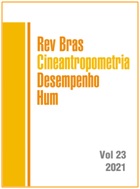Relationship between postural changes and physical and functional variables in schoolchildren aged 6-12 years
DOI:
https://doi.org/10.1590/1980-0037.2021v23e55654Abstract
The aim of this study was to evaluate the prevalence of postural changes and their relationship with BMI, pain, postures adopted in activities of the daily living (ADL), physical activity practice, gender and age (6 to 12 years). This study is characterized as cross-sectional, quantitative and descriptive. The convenience sample consisted of 840 schoolchildren. Regarding the sample characteristics, 477 (56.79%) were female aged 6-12 years (average=8.90±1.71years). Evaluations were carried out at the school premises and a questionnaire was used to collect data on gender, age, pain report, practice of out-of-school physical activities and postures adopted in ADLs. Body mass, height and posture were evaluated. Some schoolchildren (43.21%) reported not practicing physical activity outside of school, 544 (64.76%) correctly carried their backpack and 51.9% adopted correct postures to study and watch TV. Musculoskeletal pain was reported by 62.73%, and shoulders were the most affected. BMI indicated 55.6% of the sample with leanness/normal weight and 44.40% with overweight/obesity. Postural changes were present in 97.02% of students and the region with the highest number of alterations was the upper limbs. Girls presented greater number of trunk alterations (p=0.001), as well as those who did not practice physical activity (p=0.02) and alterations in the lower limbs for younger students (p=0.02) and female students (p=0.01). This study identified high prevalence of postural changes in schoolchildren.
References
Bunnell WP. Selective screening for scoliosis. Clin Orthop Relat Res. 2005;(434):40-5.
Souza Júnior JV, Sampaio RMM, Aguiar JB, Pinto FJM. Perfil das alterações posturais da coluna vertebral em adolescentes de escolas públicas do município de Juazeiro do Norte – CE. Fisioter Pesq 2011;18(4):311-6.
Rodrigues PL, Yamada EF. Prevalência de alterações posturais em escolares de Ensino Fundamental de Vila Velha (ES). Fisioter Mov 2014; 27 (3): 437-445.
Bienfait M. Os desequilíbrios estáticos: fisiologia, patologia e tratamento fisioterápico. São Paulo: Summus, 1995.
Gross J, Fetto J, Rosen E. Exame musculoesquelético. Porto Alegre: Artes Médicas Sul, 2000.
Timpka S, Petersson If, Zhou C, Englund M. Muscle strength in adolescent men and future musculoskeletal pain: a cohort study with 17 years of follow-up. BMJ Open 2013; 28 (3): 1-16.
Singla D, Veqar Z. Methods of postural assessment used for sports persons. J Clin Diagn Res 2014;8(4):LE01-4.
Corlett EM, Bishop RP. A technique for measuring postural discomfort. Ergonomics 1976; 175-182.
WHO Multicentre Growth Reference Study Group. WHO Child Growth Standards based on length/height, weight and age. Acta Paediatr Suppl 2006;450:76-85.
Kendall FP, Mccreary EK, Provance PG, Rodgers MM, Romani WA. Músculos: provas e funções. 2ª ed. São Paulo: Manole; 2007.
Santos CIS, Cunha ABN, Braga VP, Saad IAB, Ribeiro MA, Conti PBM, Oberg TD. Ocorrência de alterações posturais em escolares do ensino público fundamental de Jaguariúna, São Paulo. Rev Paul Pediatr 2009; 27 (1): 74-80.
Magee DJ. Avaliação musculoesquelética. 5ª ed. Barueri: Manole; 2010.
Pereira DSL, Castro S, Bertoncello D, Damião R, Walsh IAP. Relationship of musculoskeletal pain with physical and functional variables and with postural changes in schoolchildren from 6 to 12 years of age. Braz J Phys Ther 2013;17(4):392-400.
Lemos AT, Machado D, Moreira R, Torres L, Garlipp D, Lorenzi t, et al. Atitude postural de escolares de 10 a 13 anos de idade. Rev Perfil (UFRGS) 2005; 7: 53-9.
Borges LF, Rodrigues RB, Valente PHF, Nogueira MS, Araújo RF, Alves FAV, et al. Análise postural de alunos de 10 a 12 anos do Colégio Estadual Américo Antunes, em São Luís de Montes Belos/GO. Rev Fac Montes Belos 2015; 8(3):79-179.
Pereira JSL, Figueirôa GR. Frequência de posturas escolióticas em crianças e adolescentes: rastreio escolar. Rev Pesq Fisioter 2016; 6 (3): 247-60.
Vieira D, Beresoski C, Camargo Mz, Fernandes K, Siqueira C, Fujisawa D. Sinais precoces de escoliose em crianças pré escolares. Fisioter Pesq 2015; 22 (1): 69-75.
Souza F, Di Ferreira R, Labres D, Elias R, Sousa A, Pereira R. Epidemiologia da escoliose idiopática do adolescente em alunos da rede pública de Goiânia-Go. Acta Ortop Bras 2013; 21 (4): 223-5.
Penha P, Casarotto R, Sacco I, Marques A, John S. Qualitative postural analysis among boys and girls of seven to ten years of age Braz J Phys Ther 2008; 12 (5); 386-391.
Debs P, Arni R, Reato L. Alterações posturais na adolescência. Adolesc Saúde 2016; 13 (2): 50-57.
Sedrez J, Rosa M, Noll M, Medeiros F, Candotti C. Fatores de risco associados a alterações posturais estruturais da coluna vertebral em crianças e adolescentes. Rev Paul Pediatr 2015; 33 (1): 72-81.



